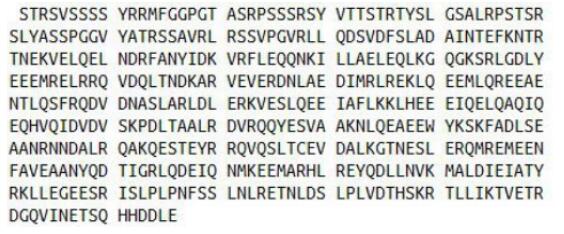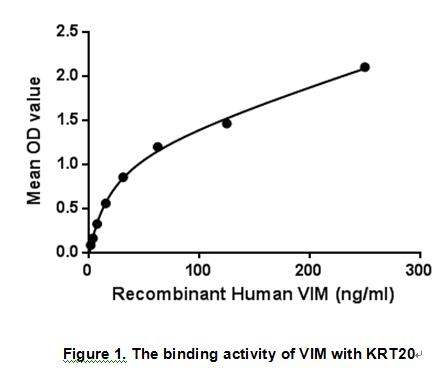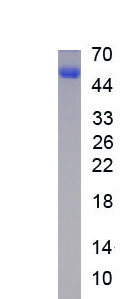Active Vimentin (VIM) 

- UOM
- FOB US$ 224.00 US$ 560.00 US$ 1,120.00 US$ 3,360.00 US$ 8,400.00
- Quantity
Overview
Properties
- Product No.APB040Hu01
- Organism SpeciesHomo sapiens (Human) Same name, Different species.
- ApplicationsCell culture; Activity Assays.
Research use only - DownloadInstruction Manual
- CategoryTumor immunityDevelopmental science
- Buffer Formulation20mM Tris, 150mM NaCl, pH8.0, containing 1mM EDTA, 1mM DTT, 0.01% SKL, 5% Trehalose and Proclin300.
- Traits Freeze-dried powder, Purity > 97%
- Isoelectric Point5.2
Sign into your account
Share a new citation as an author
Upload your experimental result
Review

Contact us
Please fill in the blank.
Activity test


Vimentin (VIM) is a type III intermediate filament (IF) protein that is expressed in mesenchymal cells.vimentin is the major cytoskeletal component of mesenchymal cells. Because of this, vimentin is often used as a marker of mesenchymally-derived cells or cells undergoing an epithelial-to-mesenchymal transition (EMT) during both normal development and metastatic progression. Besides, Keratin 20 (KRT20) has been identified as an interactor of VIM, thus a binding ELISA assay was conducted to detect the interaction of recombinant human VIM and recombinant human KRT20. Briefly, VIM were diluted serially in PBS, with 0.01% BSA (pH 7.4). Duplicate samples of 100μl then transferred to KRT20-coated microtiter wells and incubated for 2h at 37℃. Wells were washed with PBST and incubated for 1h with anti-VIM pAb, then aspirated and washed 3 times. After incubation with HRP labelled secondary antibody, wells were aspirated and washed 3 times. With the addition of substrate solution, wells were incubated 15-25 minutes at 37℃. Finally, add 50µl stop solution to the wells and read at 450nm immediately. The binding activity of VIM and KRT20 was shown in Figure 1, and this effect was in a dose dependent manner.
Usage
Reconstitute in 20mM Tris, 150mM NaCl (pH8.0) to a concentration of 0.1-1.0 mg/mL. Do not vortex.
Storage
Avoid repeated freeze/thaw cycles. Store at 2-8°C for one month. Aliquot and store at -80°C for 12 months.
Stability
The thermal stability is described by the loss rate. The loss rate was determined by accelerated thermal degradation test, that is, incubate the protein at 37°C for 48h, and no obvious degradation and precipitation were observed. The loss rate is less than 5% within the expiration date under appropriate storage condition.
Increment services
-
 BCA Protein Quantification Kit
BCA Protein Quantification Kit
-
 Molecular Mass Marker for Protein
Molecular Mass Marker for Protein
-
 Monoclonal Antibody Customized Service
Monoclonal Antibody Customized Service
-
 Polyclonal Antibody Customized Service
Polyclonal Antibody Customized Service
-
 Protein Activity Test Experiment Service
Protein Activity Test Experiment Service
-
 Electrophoretic Mobility Shift Assay (EMSA) Experiment Service
Electrophoretic Mobility Shift Assay (EMSA) Experiment Service
-
 Buffer
Buffer
-
 Lentivirus Packaging Experiment Service
Lentivirus Packaging Experiment Service
-
 Adenovirus Packaging Experiment Service
Adenovirus Packaging Experiment Service
-
 Real Time PCR Experimental Service
Real Time PCR Experimental Service
-
 Spike RBD Protein (S-RBD)
Spike RBD Protein (S-RBD)
-
 Protein G
Protein G
-
 Protein A
Protein A
Citations
- Aberrant Vimentin Methylation Is Characteristic of Breast Cancerpubmed:22315367
- Glyoxalase 1-knockdown in human aortic endothelial cells - effect on the proteome andendothelial function estimates.pubmed:27898103
- HtrA3 is a cellular partner of cytoskeleton proteins and TCP1α chaperoninPubmed:29477555
- Growth hormone induces Notch1 signaling in podocytes and contributes to proteinuria in diabetic nephropathyPubmed: 31511328
- Extracellular vesicles derived from injured vascular tissue promote the formation of tertiary lymphoid structures in vascular allograftsPubmed: 31729155
- Is Vimentin the Cause or Effect of Obstructive Sleep Apnea Development?Pubmed: 32088750
- ZNF471 modulates EMT and functions as methylation regulated tumor suppressor with diagnostic and prognostic significance in cervical cancer33566221
- Metastatic suppression by DOC2B is mediated by inhibition of epithelial-mesenchymal transition and induction of senescence33758996
- Comparison of Vimentin Levels Between Preeclamptic and Normotensive Pregnant Women
- Advanced glycation end-products associate with podocytopathy in type II diabetic patients
- Non-POU Domain-Containing Octamer-Binding (NONO) Protein Stability Regulated by PIN1 is Crucial for Breast Cancer Tumorigenicity Via the MAPK/β …








